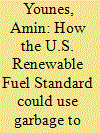| Srl | Item |
| 1 |
ID:
101412


|
|
|
|
|
| Publication |
2011.
|
| Summary/Abstract |
This work compares the technical, economic and environmental (GHG emissions mitigation) performance of power generation and ethanol production from sugarcane residual biomass, considering conversion plants adjacent to a sugarcane mill in Brazil. Systems performances were simulated for a projected enzymatic saccharification co-fermentation plant (Ethanol option) and for a commercial steam-Rankine power plant (Electricity option). Surplus bagasse from the mill would be used as fuel/raw material for conversion, while cane trash collected from the field would be used as supplementary fuel at the mill. For the Electricity option, the sugarcane biorefinery (mill+adjacent plant) would produce 91 L of ethanol per tonne of cane and export 130 kWh/t of cane, while for the Ethanol option the total ethanol production would be 124 L/t of cane with an electricity surplus of 50 kWh/t cane. The return on investment (ROI) related to the biochemical conversion route was 15.9%, compared with 23.2% for the power plant, for the conditions in Brazil. Considering the GHG emissions mitigation, the environmentally preferred option is the biochemical conversion route: the net avoided emissions associated to the adjacent plants are estimated to be 493 and 781 kgCO2eq/t of dry bagasse for the Electricity and Ethanol options, respectively.
|
|
|
|
|
|
|
|
|
|
|
|
|
|
|
|
| 2 |
ID:
186410


|
|
|
|
|
| Summary/Abstract |
The U.S. Renewable Fuel Standard (RFS) is a key federal program shifting the nation's transportation fuel mix towards lower-carbon alternatives. A 2014 update to the standard included certain types of renewable electricity as qualifying fuels, supporting vehicle electrification within the RFS for the first time. This study investigates the potential under existing regulatory authority to expand deployment of low-carbon waste-to-electricity pathways, yielding revenue that could be used to subsidize electric vehicle (EV) sales or to support other RFS-aligned climate and transport-sector goals. We find that by accounting for drivetrain efficiency in credit allocation and creating a centralized entity to accrue credits, the RFS could generate $8.7 to $24 billion in revenues annually that could be used to provide EV subsidies of $3600 to $9200 or to otherwise accelerate transport electrification. The economic potential for qualifying waste-derived bioelectricity production could meet EV fleet demand to at least 2029. Absent a federal Low Carbon Fuel Standard, or other technology-neutral fuel policy, the RFS could effectively support widespread vehicle electrification. Expansion of waste-derived electricity could mitigate or increase pollutant exposure for some populations, so policy design and implementation must pay close attention to environmental health, justice, and equity.
|
|
|
|
|
|
|
|
|
|
|
|
|
|
|
|